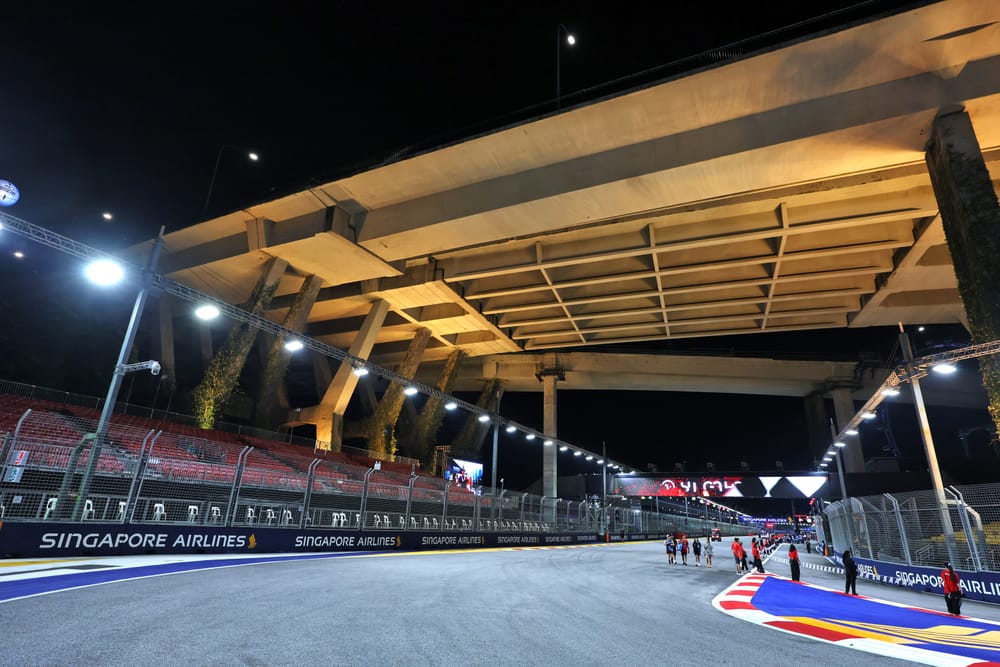Formula 1 drivers have two main doubts about the driver cooling system, which will be mandatory for each car to carry during the Singapore Grand Prix weekend, following the declaration of a ‘heat hazard’ for the event.
The ‘heat hazard’ declaration is a result of a heat index of 31C or more being forecast for the weekend, which is a measure not simply of ambient temperature but also how it feels once humidity is factored in.
The driver cooling system, which is not a spec part, carries a coolant through a series of tubes in a vest worn by the driver. This is permitted only to be water, air or an aqueous solution of sodium chloride, potassium chloride or propylene glycol.
However, drivers are permitted not to wear the vest and the integrated cooling apparatus provided 500g of ballast is carried.
This is the first heat hazard event F1 has declared, but the system has been run during races in the past, with Mercedes driver George Russell the first to do so in April’s Bahrain Grand Prix.
Most drivers have previously tried their driver cooling systems and some have questions about how long these systems will be effective for in F1’s longest race.
Carlos Sainz is not concerned about any problems resulting from this in the race given he’s contested the Singapore GP since his first outing there in 2015 without such a system, but highlighted the challenges all teams have faced with the systems.
“Teams are managing to make it work better and better every time we run it,” said Sainz. “At the beginning, we had it working more or less for half an hour. Hopefully now the whole system can work at least one hour. I've done Singapore 10 times - if it breaks or it doesn't work, I'm not worried: I'll do the race and I'll jump out fresh like I always do. But if it works, it's better because then you suffer a bit less.”
How long the cooling effect will last depends on the exact system used by each team.
Aston Martin driver Fernando Alonso said: “it should be fine for the length of the race, at least for one hour of free practice it keeps working the same from minute one to 60”.
However, Haas driver Ollie Bearman pointed to problems with ‘melting’ of what is presumably ice used in the heat exchanger, which creates a limit to the amount of energy that can be taken out of the coolant circulating around the vest before it ceases being effective.
“I guess it is going to be beneficial, [but] of course we need to run it in FP1 and FP2 and see if it actually stays cold,” said Bearman. “The only issue is that if it melts too fast you’re just circulating hot water and then it's probably heating you up more than just not wearing it. That's the trade-off.”
As well as difficulties with keeping the coolant that’s circulated through the tubing in the vests a low enough temperature to have an effect throughout the race, there are also potential technical problems that could impede the flow of the coolant and functionality of the driver cooling systems.
While well-proven in motorsport having been used in other forms of competition, notably sportscars, for many years, the cockpit of an F1 car is its own distinct challenge.
The concerns about comfort are minor but have been noted by multiple drivers. Alonso characterised the problem as “a position thing with the [safety] belt”. Mercedes driver George Russell, who is also a director of the GPDA, said that while he had problems with comfort at first this has improved.
“It’s just where the tubes on your back connect to the tubes on your front, and they have to go around your ribs,” said Russell of the comfort problems.
“When you go through high-speed corners and the g-force, you're feeling these tubes on the side of your ribs. That was definitely an issue for me at the beginning.
"They made some changes, it has been improved, but still you have these tubes going around your ribs, which is not the perfect place for it.
"There’s not many high-speed corners here in Singapore [with] high lateral G-force, so I don’t think it would be a major issue.”
It's likely that most, if not all, drivers will actively use the system this weekend. As Sauber driver Nico Hulkenberg pointed ou:t “we all have to fit the ballast anyway, [so] you might as well take the thing”.
That’s a message echoed by Aston Martin’s Lance Stroll.
“From my experience, no matter what you do, it's always a brutal race physically, mentally, with the challenges of the track, the walls, no room for error, and just the cockpit, the heat in the car just being insanely high temperatures,” said Stroll.
“So yeah, I'm going to try the vest, see if it works. It might maybe only work for five laps, and then you have no more cooling, and then it's just 50 laps of suffering.”
There’s little or no risk of the driver cooling systems causing any problems that will impact a driver’s race in any tangible way given what Stroll called additional suffering. They have been tested and proved, it’s simply a question of whether they are yet working as well as they ideally would be.
And as Sainz pointed out, it’s only the first year and it won’t be long before they are refined.
“I wasn't expecting the system to be working flat out perfectly this first year,” added Sainz. “Then, always in F1, engineers and providers keep working at it and they find solutions and they get it to work. It's how F1 works, always.”



